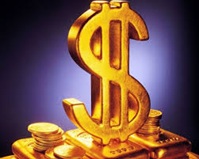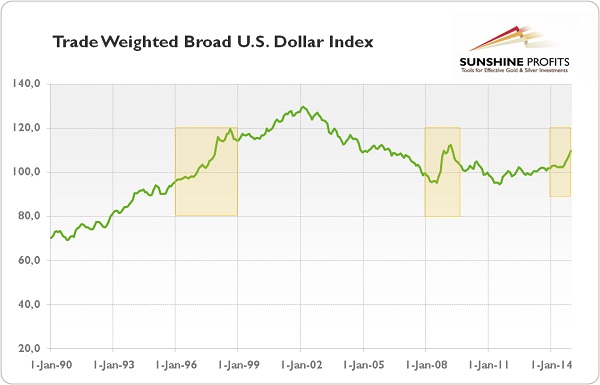What Would An Emerging Markets Crisis Mean For The US Dollar & Gold?
 We have already suggested that falling oil and other raw materials prices may be the canary in the coalmine. The gold is, however, not only a commodity, but also a currency, so the yellow metal does not have to fall during bear market in commodities. Nevertheless, its behavior depends strongly on the U.S. dollar. So, what are the prospects for the greenback?
We have already suggested that falling oil and other raw materials prices may be the canary in the coalmine. The gold is, however, not only a commodity, but also a currency, so the yellow metal does not have to fall during bear market in commodities. Nevertheless, its behavior depends strongly on the U.S. dollar. So, what are the prospects for the greenback?
The current macroeconomic situation indicates that U.S. dollar will be rallying, at least in the near future. We have already pointed out in the last Market Overview, that BoJ and ECB are now considered as more dovish, so the greenback is seen as “the best looking of the ugly sisters.” In this Market Overview, we would like to add another piece to the macroeconomic puzzle: the emerging markets carry trade. What is it and why is it so important?
The carry trade simply means borrowing in a low-interest currency, such as the U.S. dollar, and investing in the higher yielding domestic instruments of emerging markets. Remember the Asian financial crisis? Back then – in 1997 – the carry trade was the reason behind the collapse. And there are many signs that history will repeat itself. This is how it works this time: Fed (and other central banks of developed countries) lowered interest rates to ultra-low levels (so-called Zero Interest Rate Policy, or just ZIRP), which caused a global search for yield. Therefore, a lot of Fed’s cheap money went into emerging markets (but also into Australia and Canada), especially BRIC countries, an especially hot investment theme after the 2008 crash.
The most important thing here is that the falling U.S. dollar strengthened the carry trade, because it generated additional profits. When you borrow greenbacks, you prosper from a fall of its value. The bear market in the U.S. dollar was also very good for commodity prices, which additionally helped boost many emerging markets (think about Brazil or Russia).
So now it should be clear why the rising greenback may be a sign of renewed global turbulence. The strengthening of the U.S. dollar directly erases investors’ gains from the interest rate differential, inducing them to withdraw capital from emerging markets. Simply put: the end of QE and expected hike of interest rates boosted the greenback and now threatens emerging markets’ carry trade. We have already witnessed a decline in emerging markets bond indices, as well as some outflows from Emerging Markets ETFs (during only one week of December 2014 investors withdrew more than $2.5 billion from U.S. exchange-traded funds that buy emerging-market stocks and bonds last week, the biggest outflow since January 2013). We have also seen a fall of a Bloomberg index tracking 20 of the most traded emerging-market currencies to the lowest point since the end of 2003. The signs of contagion should not be neglected. Similarly, the U.S. dollar index, including a broad group of major trading partners (many of them are emerging markets) is booming right now, just as during the Asian financial crisis or Lehman’s collapse (see it in graph 4).
Graph 4: Trade Weighted Broad U.S. Dollar Index from 1990 to 2014

Now it is a time for the million-dollar question: how the investors unwind the carry trade? Right, you guessed it! They sell the emerging-market assets and shift the capital back into the currency they borrowed the money in, i.e., mostly the U.S. dollar. Therefore, there is a positive feedback: the more the greenback rises, the greater the losses in carry trade, so the greater flight into U.S. dollars, which increases demand for greenback and its price, and so on.
This process can last unless, e.g., emerging markets’ central banks hike the interest rates. December 16, 2014, the Central Bank of Russia increased a key interest rate by 650 basis points to 17 percent in order to prevent outflows from the Russian ruble. However, the results are not certain. Such a hike may encourage investing again in rubles, but on the other hand it may “tighten domestic liquidity, putting a strain on the domestic corporate sector”. It could also trigger a banking crisis, because Russians started withdrawing rubles out of their bank accounts and converting them to foreign currencies, and the Russian interbank lending rate has soared to 28.3 per cent, the highest level since the peak of the financial crisis on January 2009.
There are three more factors reinforcing the possible future U.S. dollar surge. First, the extremely loose monetary policy of the Bank of Japan encourages the yen carry trade. Some of the investors are now borrowing the yen, converting into U.S. dollars and investing in U.S. Treasuries.
Second, a strong greenback means low commodity prices, so it may additionally worsen the situation in some emerging markets, especially Venezuela or Russia, but also some developed commodity-exporting countries, like Canada or Australia. And we are not talking about small amounts. The Bank of America Merrill Lynch estimated that since 3Q 2008 to 3Q 2013, “the US Federal Reserve QE has unleashed a massive $2 trillion debt-driven carry trade into emerging markets”, while the whole off-shore lending in US dollars is assessed at $9 trillion, according to the Bank for International Settlements. Therefore, the inflows to emerging markets may stop. Some economists admit that even outflows are possible. According to the World Bank, the private capital inflows to emerging markets could drop 50 percent if long-term U.S. bond yields rise one percentage point.
Third, an initial wave of crises can push the USD higher, because of flight into safety, and lead to the next perturbations. Just recall the Mexican “Tequila Crisis” of 1994, following initial strengthening of U.S. dollar, then the Asian financial crisis in 1997, next rise of greenback and subsequent fall of oil prices and the Russian crisis in 1998. It is true that this time developing nations have more flexible exchange rates, higher foreign reserves and less government debt denominated in dollars, but on the other hand those obligations were just replaced by the corporate dollar debts. Also, the order may be different, given the desperate interest rates hike in Russia.
The end of the emerging market carry trade is not certain and the party could go on, if only Fed (or the other main central banks) changes its current stance (for example, based on poor labor market data or some deflationary shock). However, we believe that it is better to start preparing for a post-QE world. Although the end of QE3 did not rule out loose monetary policy, it increased the Fed’s credibility. More and more economists, including the Bank for International Settlements, fear that the current cycle of Fed’s relative tightening (compared to BoJ and ECB) will lead to the next Asian crisis.
What does it all mean for gold? Well, a history of the Asian crisis teaches us that emerging market crashes do not necessarily result in a gold bull market, because investors then resort to the greenback and U.S. Treasuries. The falling prices of oil and other commodities reflect either a rise in the U.S. dollar or global slowdown. Because gold generally doesn’t sync with stocks or bonds, it is the best performing asset during this stage of business cycle. However, investors should not assume that gold automatically gains if the stock market collapses, because a lot depends on the behavior of the U.S. dollar. There are no two identical business cycles and no two identical crises, and there are many variables and factors which could easily change the macroeconomic situation, like a Russian interest rates hike or Fed’s retreat from the planned hike of interest rates. And we are not yet entering recession or witnessing global havoc. We would just like to prepare investors for the worst-case scenario, which does not need to materialize. Stay tuned!
********
Courtesy of Sunshine Profits‘ Market Overview Editor

















